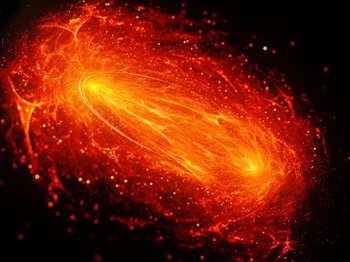
How Raw Honey Could Save Your Microbiome (and Travel Back In Time)
Did you know that there are billions of years of biological information encoded within your cells, and that depending on what you do or do not eat, the information is activated or remains latent?
It is a biological fact that the distant past is embedded within the present. No one could have described this more aptly and tangibly than Thich Nhat Han when he said:
If you look deeply into the palm of your hand, you will see your parents and all generations of your ancestors. All of them are alive in this moment. Each is present in your body. You are the continuation of each of these people."
In fact, each cell in your body, along with all the cells in all living creatures on the planet today, derive from a last universal common ancestor (LUCA) estimated to have lived some 3.5 to 3.8 billion years ago in the primordial ocean. While this may strike the reader as an unusual concept, even Charles Darwin acknowledged this phenomenon in Origin of Species (1859)1:
"Therefore I should infer from analogy that probably all the organic beings which have ever lived on this earth have descended from some one primordial form, into which life was first breathed."
The germline cells within our bodies (sperm and ovum) represent a quasi-immortal and unbroken biological thread tying us all back, through an almost infinite number of cell replications, to LUCA. These germline cells represent, against all odds, the resilience of biological systems to persist through incalculably vast stretches of time and innumerable vectors of adversity. They are "deathless" relative to somatic cells in that their biological information has been passed down from generation to generation for billions of years without interruption, and that will continue to be passed forward within the successfully conceived progeny of all the species inhabiting this planet today.

And so, biological entities are unique insofar as they inhabit the present while containing within themselves information stretching so far back in the distant past as to approach geologic time scales.
The Microbial Basis for Human Identity
Before we delve into nutrition as a form of "microbial time travel," we must first provide context by taking a brief look at how our species' self-definition has been completely transformed by the discovery that we are at least as much "germs" as we are "human."
We now know that we are more microbial than human. Constituted by at least 10 times more bacterial, viral, and fungal cells than actual human cells, we are more accurately described (at least in biological terms) as a "meta-organism" than a hermetically-sealed off body isolated from outside life.
Perhaps even more profound is the fact that the total genetic information in our bodies is about 99% microbial in origin, with many of these microbes performing life-sustaining functions for digestion, immunity, and even cognition. Even when explore only the "private" genetic contribution of our cells, we find that the human genome is about 10% viral (retroviral) in origin, and that "our" mitochondria are actually "alien" in origin: somewhere around 1.5 billion years ago an ancient bacteria entered into symbiotic relationship with our cells to perform both oxygen-detoxifying and energy-producing functions by losing their independence and becoming our mitochondria. [Note: Learn more about the implications of the microbial basis for human identity in the article: "How The Microbiome Destroyed the Ego, Vaccine Policy, and Patriarchy."]
.jpg)
When we look at ourselves through this microbial lens, where we "end" and the living and breathing environment "begins" is no longer as clear as the boundary of our skin. What we eat or expose ourselves chemically, for instance, not only becomes of crucial significance in determining the state of our health and disease risk, but to our very identity. This information is beginning to affect the way we look at ourselves as a species in evolutionary terms. In fact, the hologenome theory of evolution states that we are a "holobiont," a host whose fate is and always was inseparably bound to all its symbiotic microbes. As with classical evolutionary theory on our how genes evolve, selective pressures from the environment have shaped the types and numbers of microbes that now form the basis for both our health and disease susceptibility. And what are some of the most important "selective pressures" that have gone into creating our holobiont selves over the course of unimaginably vast swaths of time? Dietary, environmental, and cultural ones, of course.
When Hippocrates said "we are what we eat," this was true not only in molecular terms, i.e. the food we eat produces molecular building blocks from which our bodies are constructed, but also in microbial terms, i.e., the microbes we expose ourselves to and cultivate through nutrition affect and/or permanently alter our holobiont selves. Which leads us to the topic of honey and "microbial time travel."
Honey, Would You Please Pass The Genome?
While we often think of our "cave man" ancestors as being shaped primarily by their "meat-based" diet, and the harnessing of fire for cooking, acquiring and eating honey may have been an equally crucial dietary determinant in our evolutionary trajectory as well. According to one researcher, Alyssa Crittendeyn, PhD, honey helped make us human:
It appears that the human sweet tooth has a long history in human evolution. New research proposes that honey may have been important in human evolution. Upper Paleolithic (8,000 - 40,000 years ago) rock art from all around the world depicts images of early humans collecting honey. The images range from figures climbing ladders to access hives residing high in trees to figures smoking out hives filled with honeycomb. Honey and bee larvae are important foods consumed by many populations of hunters and gatherers worldwide. Foragers in Latin America, Asia, Australia, and Africa include honey and bee larvae as major components of their diet. The Hadza hunter-gatherers of Tanzania, the population with whom I work, even list honey as their number one preferred food item!"
So, while our ancestors may have consumed honey, what does it have to do with our microbial identity?

Honey actually contains a range of beneficial microbes contributed by bees and the plants they forage, including lactic-acid producing bacteria (Lactobacilli), and when eaten raw, may contribute health-promoting strains to our bodies. These bacteria have been identified as indispensable to the immunity of the individuals and the hive as a whole, as well as in affecting the behavior of the different types of bees that inhabit these complex colonies. Considering the possibility of our ancient co-evolutionary relationship with honey, is it possible that our own immune systems and microbial populations share dependency on honey-based microbes?
There is no doubt that in a day and age where the previously timeless and unbroken chain of microbial custody between vaginally birthed and exclusively breastfed offspring has been profoundly disrupted, our inner microbial terrain has become completely ravaged. Add to this the daily barrage of food-like but synthetic dietary inputs, along with a battery of antimicrobial toxicants unleashed by the industrial revolution and now festering in the post-industrial chemical soup we are all now immersed in, the intimate link between the human and microbial sides of the holobiont's multiplicitous identity has all but become irreparably severed. Could honey help heal these wounds? Could eating ancestral foods infused with equally ancient symbiotic bacteria help us recover, and "travel back" in biological time to a far more stable state of health? Could these bacteria and their metabolic byproducts provide epigenetically meaningful information to regulate the expression of our own genome? Could this also explain why honey has been identified to have at least 100 health benefits?
An Age Old Relationship
A fascinating study published in PLoS in 2012 might help answer this question. Titled, "Symbionts as major modulators of insect health: lactic acid bacteria and honeybees", it characterized the diverse and ancient lactic acid bacteria populations of microbiota within the honey crop of honeybees and related species. Amazingly, they discovered species from the Lactobacillus and Bifobacterium genera in these bees that suggest a 80,000,000 year or older history of association. This means that honeybees and their honey may contain bacteria that humans may have maintained contact with and ingested throughout the entire course of their evolution as foragers of honey, which would also include our pre-human predecessors. Within the confines of their bodies, these insects may have provided an environment for these ancient symbiotic bacteria to survive intact for millions of years, enabling animals (like humans) to periodically replenish their microbiomes through consuming bee products like honey infused with them.

Since food is not just "fuel" or "building blocks" for the body, but informational, containing "epigenetic inheritance systems" as real and valid to the expression of our DNA as the primary nucleotide sequences in our genome, this discovery has profound implications. For those whose microbial heritage has been decimated and/or supplanted with genetically altered (via recombinant or chemical induction) food stuffs, eating real, wild-harvested raw honey might re-infuse the body with information and microbes that not only have important health-promoting but are indispensable for the informational integrity of our species identity.
This is, of course, not limited to honey. Technically, everything we eat (or do not eat) will affect the trajectory of our health, both individually, and as a species. For example, the present agricultural system carpet-bombs monocultured land with biocides often destroying the profound microbial biodiversity vital to gene-regulatory information and proxy physiological capabilities, i.e. the production of enzymes and anti-microbial factors that our genome itself does not possess. This is why seeming "superstitious" farming practices such as taking wild-soil (from old growth systems) and using it as inoculant in newer farming land may be so effective at producing vitally nourishing food. These old-growth microbial communities, perhaps a byproduct of millions of years of coevolution, are capable of contributing a wide range of biotransformed soil metabolites for the plant's nutritional needs, as well as infusing the edible plants themselves with strains of bacteria, fungi, and even viruses, important to our own health.
The American herbalist Paul Schulick once aptly named the interstitial layer of microbial communities within the soil and our gut a "life bridge." This bridge can be visualized both "spatially" as a physiological bridge which connects our bodies via microbes directly to the Earth, forming an inseparable whole (the holobiont), and temporally, by bridging the gap between the present and the ancient past.
One thing is for sure, the more we explore the complexity of human physiology and optimal health, the more mysterious and amazing life appears to be.
© [05/01/2023Article Date] GreenMedInfo LLC. This work is reproduced and distributed with the permission of GreenMedInfo LLC. Want to learn more from GreenMedInfo? Sign up for the newsletter here //www.greenmedinfo.com/greenmed/newsletter.
------------------------------------------------------------------------------------------------
Pedagogy Education offers online continuing education courses in a variety of ways to meet your education goals and budget!
Courses may be purchased individually, or in packages (a bundle of courses, offered at a 10% discount). To view our entire catalog of education, click here. We offer a huge selection of infusion, vascular access, and state-specific IV "certification" courses!
We have annual memberships available to individuals or facilities who want to offer their staff access to a library of education for an entire year. Click here to view our Infusion and Vascular Access CE Membership. Facilities can visit our Annual Memberships to learn more about our nurse and nurse aide custom membership options and to view pricing!
Ready to purchase a course, package, or membership? Start here by creating your account! Want to receive our emails with notifications of new course releases and coupon codes good for discounts on courses? Sign up for our emails here. We would LOVE to have you join us on our social media pages, follow us on Facebook, LinkedIn, Instagram, and Pinterest. Watch out for exclusive promo codes!

